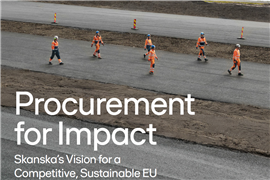Read this article in French German Italian Portuguese Spanish
Green light for world’s first fully-decarbonised cement production plant
25 September 2025
Heidelberg Materials and the UK Government have reached a funding agreement to build the world’s first carbon capture facility that enables the fully-decarbonised production of cement.
 Padeswood represents Heidelberg Materials’, and the world’s, second industrial-scale CCS initiative in the cement sector to reach Final Investment Decision. Image: Heidelberg Materials
Padeswood represents Heidelberg Materials’, and the world’s, second industrial-scale CCS initiative in the cement sector to reach Final Investment Decision. Image: Heidelberg Materials
The Padeswood plant – located in north Wales – will become the world’s first cement plant with a fully-decarbonised cement production process.
The facility is designed to capture around 800,000 tonnes of CO₂ annually, equalling nearly all the plant’s CO₂ emissions and the project is now is entering the execution phase.
After the opening of Brevik CCS in June 2025, Padeswood CCS will be Heidelberg Materials’ second facility enabling the production of evoZero, the world’s first carbon captured net-zero cement, at a much higher capacity. This will significantly increase the availability of evoZero across Europe.
Michael Shanks, Energy Minister in the UK Department for Energy Security and Net Zero, said, “This trailblazing project in a cement plant showcases the North Wales workforce on the global stage – leading the charge in the clean industries of the future and powering Britain’s reindustrialisation through this UK-first venture.”
Dr Dominik von Achten, Chairman of the Managing Board of Heidelberg Materials, said that the Padeswood plant project was at an advantage due to the company already completing a similar project, Brevik CCS, in Norway.
“At Padeswood, we have an invaluable advantage: We’re building on the knowledge and learnings developed at Brevik by working closely with the teams behind its success – sharing best practices with our UK colleagues, whose expertise and enthusiasm will drive the project forward,” he said.
Padeswood CCS will produce net-zero cement by capturing almost all of the CO₂ emissions from the kiln and the combined heat and power (CHP) plant. The emissions captured from the kiln include CO₂ from biomass fuels, mainly from domestic food, wood and paper wastes that cannot be economically recycled.
By capturing these emissions, the plant has the potential to become a carbon sink: This is made possible by using a high proportion of biogenic alternative fuels in the cement production process, made up of plant-based materials that have absorbed CO₂ during their lifecycle. If the associated carbon emissions are then captured and stored, this reduces the total amount of CO₂ in the atmosphere.
Construction of the carbon capture facility at the Padeswood cement plant will start later this year, with commissioning foreseen in 2029. The captured CO₂ will be compressed and transported via an underground pipeline for secure storage under the seabed in Liverpool Bay as part of the HyNet North West project.
STAY CONNECTED



Receive the information you need when you need it through our world-leading magazines, newsletters and daily briefings.
CONNECT WITH THE TEAM










